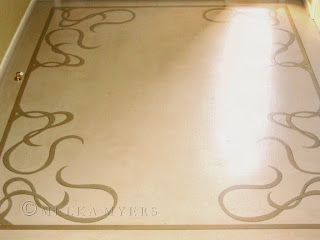Art Nouveau was an innovative international style of modern art that became fashionable from about 1890 to the First World War. Arising as a reaction to 19th-century designs dominated by historicism in general and neoclassicism in particular, it promulgated the idea of art and design as part of everyday life. Henceforth artists should not overlook any everyday object, no matter how functional it might be. This aesthetic was considered to be quite revolutionary and new, hence its name - New Art - or Art Nouveau. Hence also the fact that it was applied to a host of different forms including architecture, fine art, applied art, and decorative art.
Types of Designs
In line with with the Art Nouveau philosophy that art should become part of everyday life, it employed flat, decorative patterns that could be used in all art forms. Typical decorative elements include leaf and tendril motifs, intertwined organic forms, mostly curvaceous in shape, although right-angled designs were also prevalent in Scotland and in Austria. Art made in this style typically depicted lavish birds, flowers, insects and other zoomorphs, as well as the hair and curvaceous bodies of beautiful women. For Art Nouveau architectural designs, see the exaggerated bulbous forms of the Spanish architect Antoni Gaudi (1852-1926), and the stylistic Parisian Metro entrances of Hector Guimard (1867-1942).
Colors: soft, muted colors were often used so select from a palette assortment of sage and olive green, mustard yellows and brown. Pair those up with beautiful shades of lilac, violet and purple. Peacock blue is stunning against a white backdrop so do not be afraid to paint your walls in brilliant white or in an off-white shade.
Walls: you could select a magnificent wallpaper like that seen in the image above or in the below left bedroom, to act as a feature wall. There are incredible ranges to suit art nouveau interior design or why not just keep your walls white and elegant looking. White or off white tiles interspersed with a patterned one would certainly add to the authenticity of your look.
Floors: should be parquet to resemble the floor finish of the marquetry that was often used. Keep the timber in natural mid tones or for a modern twist you could whitewash it with paint.
Decor: wasn't always simple, it was however decadent and ornamental. Take a look at the ensemble below. Here we see a collection of necessary storage, developed into on piece. It has simple touches of design and staying true to this period it is warm in color and has a beautiful mix of curvy and straight lines flowing up either side. The organic look of art nouveau interior design always grows from the ground up.
Lighting: no art nouveau interior design would be complete without a Tiffany lamp like the one shown below. Constructed from a bronze base the Tiffany lamps have an umbrella shaped shade, made from spectacularly, interesting stained glass.

_(5469543414).jpg)



No comments:
Post a Comment